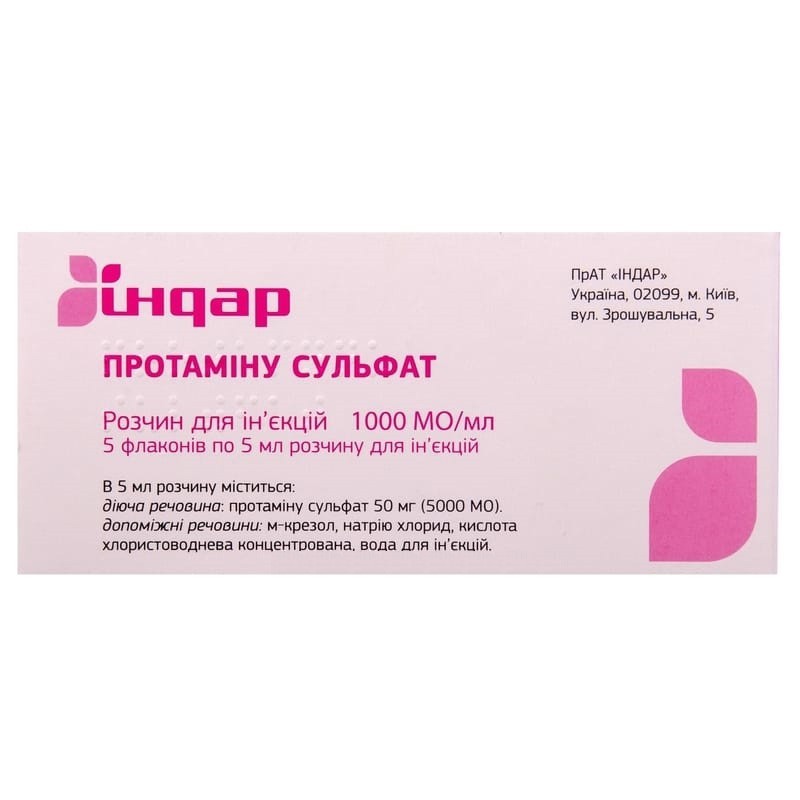



 Secure and encrypted payment processing
Secure and encrypted payment processing We ship to over 40 countries including the USA, UK, Europe, Australia and Japan
We ship to over 40 countries including the USA, UK, Europe, Australia and Japan Guaranteed refund or reship if you haven't received your order
Guaranteed refund or reship if you haven't received your orderthe active active ingredient of the drug - protamine sulfate has a hemostatic effect. neutralizes the effect of heparin, reduces the severity of its anticoagulation properties. forms stable complexes with heparin, while heparin loses its ability to inhibit blood coagulation. complexation is due to the abundance of cationic groups (due to arginine), which bind to the anionic centers of heparin. effective in some types of hemorrhages associated with heparin-like blood clotting disorders.
Pharmacokinetics With iv administration, the effect occurs instantly (“on the needle”) and lasts about 2 hours. Protamine sulfate is excreted from the body mainly by the kidneys and, to a lesser extent, with bile. Together with heparin forms an inactive complex, whose half-life is 24 minutes. Protamine sulfate is inactivated in plasma by enzymes, while the protamine-heparin complex is likely to break down into its constituents with the release of heparin.
Apply to neutralize the excessive unwanted anticoagulant effect of heparin: overdose, before and after operations with heparin therapy, after surgical interventions on the heart and blood vessels using extracorporeal circulation during hemodialysis using heparin.
Protamine sulfate 10,000 IU should be used as a very slow iv or s / c injection.
The required amount of Protamine sulfate 10,000 IU depends on the level of heparin circulating in the blood; given the short half-life of heparin, the dose of protamine required to neutralize it is reduced in accordance with the time that has elapsed since the administration of heparin. With bolus injections of heparin, the dose of protamine sulfate depends on the time elapsed since the injection of heparin.
Table 1The dose of protamine sulfate depending on the time elapsed since the injection of heparin
| Time elapsed since heparin injection, min | The dose of protamine sulfate in terms of 100 IU (1 mg) of heparin, IU (mg) |
| 15–30 | 100–150 (1–1,5) |
| 30–60 | 50–75 (0,5–0,75) |
| 2 h | 25–37,5 (0,25–0,375) |
In isolated cases when elimination of bleeding caused by heparin is required, the dose of Protamine sulfate 10,000 IU should be 50% of the last dose of heparin administered (in IU). If heparin is administered intravenously to the patient, it is necessary to stop the infusion and administer 2500-3000 IU (25-30 mg) of protamine sulfate by slow intravenous injection. With sc injection of heparin, the dose is 100-150 IU (11.5 mg) for every 100 IU (1 mg) of heparin. The first 2500–5000 IU (25–50 mg) of protamine sulfate should be intravenously injected intravenously, and the remaining dose should be intravenously dripped for 8–16 hours.
Protamine sulfate 10,000 IU can be used to inactivate heparin after extracorporeal dialysis, depending on the required dose. In the case of extracorporeal circulation during surgical intervention, the dose is 150 IU (1.5 mg) for every 100 IU (1 mg) of heparin.
If the level of heparin is unknown, it is recommended to start the administration of Protamine sulfate 10,000 IU in a dose of not more than 1 ml in the form of 1000 IU (10 mg / ml) for a slow iv injection.
To prevent overdose of protamine, it is necessary to continue the administration of the drug until the normalization of thrombin time.
The dose of Protamine sulfate 10,000 IU is determined based on the results of periodic coagulation tests (thrombin time, activated partial thromboplastin time).
Patients previously treated with protamine or protamine-containing insulin, or fish allergic patients who have undergone vasectomy, are at an increased risk of developing anaphylactic reactions. In order to prevent such reactions, Protamine sulfate 10,000 IU should be administered slowly, preferably drip, after dissolving 0.9% in 100-200 ml of sodium chloride solution.
After opening the bottle, the remains of the drug should be disposed of in accordance with current requirements.
Hypersensitivity to the components of the drug. idiopathic and congenital hyperheparinemia (in such cases, protamine sulfate is ineffective and may even increase bleeding); severe arterial hypotension, thrombocytopenia, adrenal insufficiency, hypovolemia.
From the side of the immune system: allergic reactions, including anaphylactic and anaphylactoid reactions, urticaria, angioedema, anaphylactic shock. in isolated cases, allergic reactions, including shock conditions, are noted. risk factors for such reactions may include fish allergies, a vasectomy, protamine-zinc treatment with insulin or protamine to inactivate heparin.
From the side of the heart: vasodilation, left ventricular heart failure or general heart failure with pulmonary hypertension.
From the respiratory system, chest and mediastinal organs: pulmonary edema; bronchospasm, non-cardiogenic pulmonary edema.
On the part of the blood and lymphatic system: thrombocytopenia, leukopenia.
If protamine IV is injected too quickly, nausea, vomiting, flushing, bradycardia, dyspnea, severe arterial hypotension, or hypertension can occur.
During therapy, monitoring of blood coagulation parameters is necessary. before the introduction, you should make sure that the patients blood volume is adequate (hypovolemia increases the risk of collapse). if there is a suspicion of a possible development of an allergic reaction to protamine, a test dose should be administered before prescribing the drug against the background of adequate anti-allergic therapy. too fast administration of the drug can cause a sensation of heat, flushing of the skin, decreased hell, bradycardia, a feeling of lack of air, allergic reactions.
Prescribing protamine is associated with a risk of anaphylactic reactions that can lead to bronchospasm, collapse and cardiac arrest. Therefore, all measures should be followed.